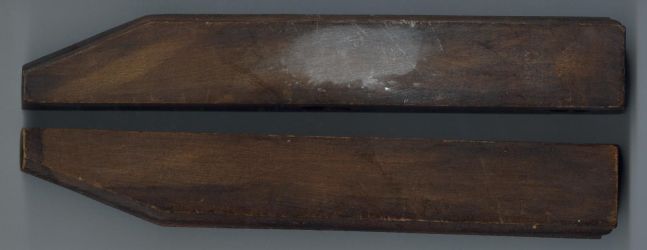 Note the chamfering along the outside, and down the slope to the nose, but not
down the nose.
Note the chamfering along the outside, and down the slope to the nose, but not
down the nose.
Top Page > Clamps as Products > Makers of Wooden Clamps (WC) > Sandusky
Table of Contents
At the moment, I have little information on when each type appeared.
According to the catalog of 1877, the material of the screws is second growth hickory, and the jaws are maple, or beech.
The catalog of 1925 says that the jaws are of white oak.The catalog of 1925 also warns that "there is no standard thread common to all makes."
The screws are two or four inches longer than the jaws, according to the catalogs.
No examples of this type are known.
The jaws have a recessed quarter round chamfer on five edges, a clear contrast from Type 3.
 Note the chamfering along the outside, and down the slope to the nose, but not
down the nose.
Note the chamfering along the outside, and down the slope to the nose, but not
down the nose.
The spindles of Type 2 look very similar to the spindles of Type 3.
 The through spindle has a handle with the customary waisted shape. Notice the
taper from the cylinder to the end of the handle. Notice also the perfectly flat
end to handle of the through spindle.
The through spindle has a handle with the customary waisted shape. Notice the
taper from the cylinder to the end of the handle. Notice also the perfectly flat
end to handle of the through spindle.
The thread was produced by a double cutter: a shallow rounded cutter, and a deeper V-cutter.
The tip of the spindle is flat across. There is (at least in my specimen) a pronounced
pit, surrounded by a circular groove, where the thread cutting lathe dug into
the end.

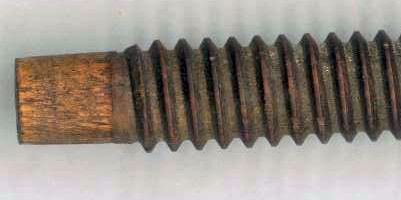 Note the not-quite flat end to handle of the stopped spindle, and a conical tranistion
to the cylinder, which bulges slightly. The transition to the end looks like
an Aldrich. Note too the rounded transition from the end of the handle to the
shaft.
Note the not-quite flat end to handle of the stopped spindle, and a conical tranistion
to the cylinder, which bulges slightly. The transition to the end looks like
an Aldrich. Note too the rounded transition from the end of the handle to the
shaft.
The tip of the stopped spindle has a slight taper from the point of maximum diameter toward the end. The end is flat. The stub has a pronounced pit, surrounded by a circular groove, where the thread cutting lathe dug into it.
The thread was produced by a double cutter: a shallow rounded cutter, and a deeper V-cutter.
The maker's mark is
SANDUSKY TOOL CO in a scroll over OHIO. In the only example, the mark is on the
side of the jaw, in the vicinity of the through screw.
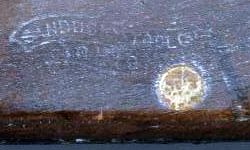 Notice the use of both serif and sans-serif fonts in the mark.
Notice the use of both serif and sans-serif fonts in the mark.
Many of these pictures are provided through the generosity of John Adams. The quadrille grid backgrounds are quarter inch squares, and provide a sense of scale.
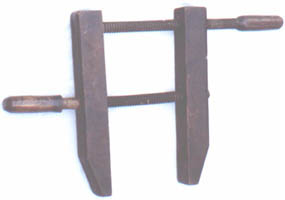 At a distance, there is little distinctive to a Sandusky. Up closer, you can
see the degree of waist of through handle, the double taper on the stopped handle,
the quarter round chamfering on 5 edges of the jaws.
At a distance, there is little distinctive to a Sandusky. Up closer, you can
see the degree of waist of through handle, the double taper on the stopped handle,
the quarter round chamfering on 5 edges of the jaws.
The jaws have a quarter round chamfer on five edges.
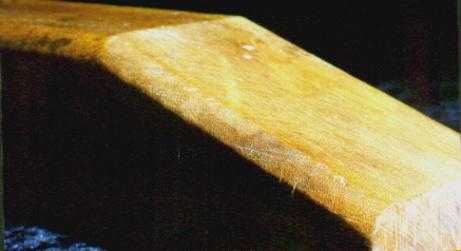 Note the quarter round chamfering along the outside, and down the slope to the
nose, but not down the nose.
Note the quarter round chamfering along the outside, and down the slope to the
nose, but not down the nose.
For the chamfering of the back, see the back below.
There is an anomaly to the two spindles in the specimen I have. The through spindle is hand cut, while the stopped spindle is lathe cut.

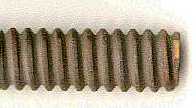 Notice the slight taper to the cylinder, and the almost symmetrical tapers from
the cylinder to the shaft and to the end of the handle. Notice also the perfectly
flat end to the through spindle.
Notice the slight taper to the cylinder, and the almost symmetrical tapers from
the cylinder to the shaft and to the end of the handle. Notice also the perfectly
flat end to the through spindle.
The through screw has a handle with the customary waisted shape; the tip of the screw is sometimes a truncated cone, sometimes flat across. There is (at least in my specimens) a pronounced pit where the thread cutting lathe dug into the end.
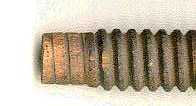
 Note the not-quite flat end to the stopped spindle. Note too the slight waist
and the rounded transition to the end of the handle.
Note the not-quite flat end to the stopped spindle. Note too the slight waist
and the rounded transition to the end of the handle.
The stopped screw has a handle which is not cylindrical. It has a slight taper from the point of maximum diameter toward the end. The end is flat. The transition to the end looks like an Aldrich. The stub has a pronounced pit where the thread cutting lathe dug into it.
The maker's mark is
SANDUSKY TOOL CO in a semi-circular arch over SANDUSKY OHIO.
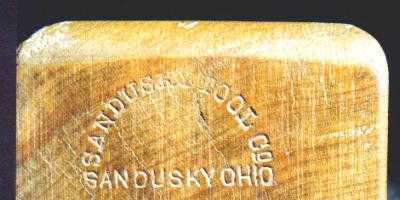 This shows clearly the arch over line mark of Sandusky. Notice too the use of
both serif and sans-serif fonts in the mark.
This shows clearly the arch over line mark of Sandusky. Notice too the use of
both serif and sans-serif fonts in the mark.
It also shows the quarter round chamfering on the jaw, around the outside, but
not on the edges between the back and the top/ bottom.
These clamps are marked Ogontz Tool. No examples of this type are known.
last revised and validated
Copyright © 1996- Wooden Clamp Journal